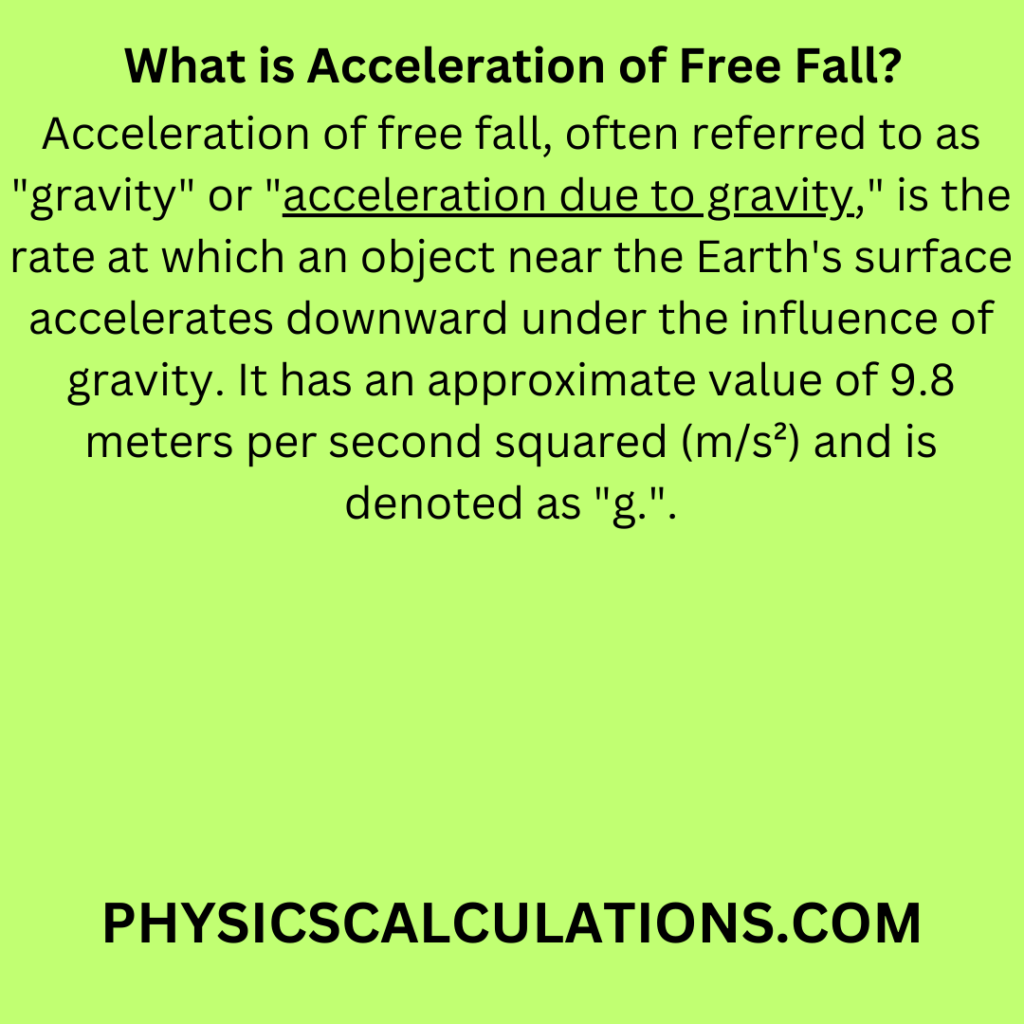What is Acceleration of Free Fall?
Acceleration of free fall, often referred to as “gravity” or “acceleration due to gravity,” is the rate at which an object near the Earth’s surface accelerates downward under the influence of gravity. It has an approximate value of 9.8 meters per second squared (m/s²) and is denoted as “g.”.

Physics is a fascinating subject that allows us to comprehend the fundamental laws governing the universe. One of the very important concepts in physics is the acceleration of free fall, often symbolized by ‘g.’
Explanation:
Acceleration due to gravity, commonly referred to as the acceleration of free fall, represents the acceleration experienced by any object when it is allowed to fall under the influence of gravity alone, without any other forces acting on it. In the absence of air resistance or any other significant factors, this acceleration remains nearly constant close to the Earth’s surface.
Finding the Value of ‘g’:
In order to comprehend this concept better, we must first determine the numerical value. The standard value of ‘g’ on the surface of the Earth is approximately 9.81 meters per second squared (m/s²). This value is remarkably consistent for most practical purposes, though it can vary slightly depending on your location.
Significance of ‘g’:
Now that we know the value of ‘g,’ let’s discuss its significance in the world of physics.
- Universal Constant: ‘g’ is a universal constant that applies to all objects near the surface of the Earth. This uniformity allows physicists to make precise calculations and predictions.
- Determining Object Behavior: ‘g’ plays a pivotal role in understanding how objects behave in free fall. It affects the speed at which objects fall and the distance they travel during free fall.
Formula:
To calculate the acceleration of free fall, you can use the formula:
g = F/m
Where:
- ‘g’ is the acceleration of free fall.
- ‘F’ is the force of gravity.
- ‘m’ is the mass of the object.
Solved Problem:
Let us say we have a 5-kilogram object. To solve this problem, we can use the formula mentioned above.
g = F/m = (5kg x 9.81m/s2) / 5kg = 9.81m/s2
This calculation reaffirms the value of ‘g’ on the surface of the Earth as 9.81 m/s².
Relation with Newton’s Laws:
The concept of acceleration of free fall is deeply intertwined with Newton’s laws of motion. According to the second law, the force acting on an object is equal to the mass of the object multiplied by its acceleration (F = ma). In the case of free fall, the only force acting on an object is gravity, making it a perfect illustration of Newton’s laws.
Practical Applications:
Understanding this concept has practical applications in various fields:
- Astronomy: It helps calculate the acceleration of objects on other celestial bodies.
- Engineering: It’s crucial for designing structures like elevators, bridges, and amusement park rides.
- Sports: It’s essential in sports science, particularly in activities involving jumping and falling.
Summary:
The acceleration of free fall, symbolized by ‘g,’ is a fundamental concept in physics. It provides a basis for understanding how objects behave when influenced solely by gravity. With a value of approximately 9.81 m/s² near the Earth’s surface, it plays a pivotal role in scientific calculations, from determining the behavior of falling objects to engineering applications.